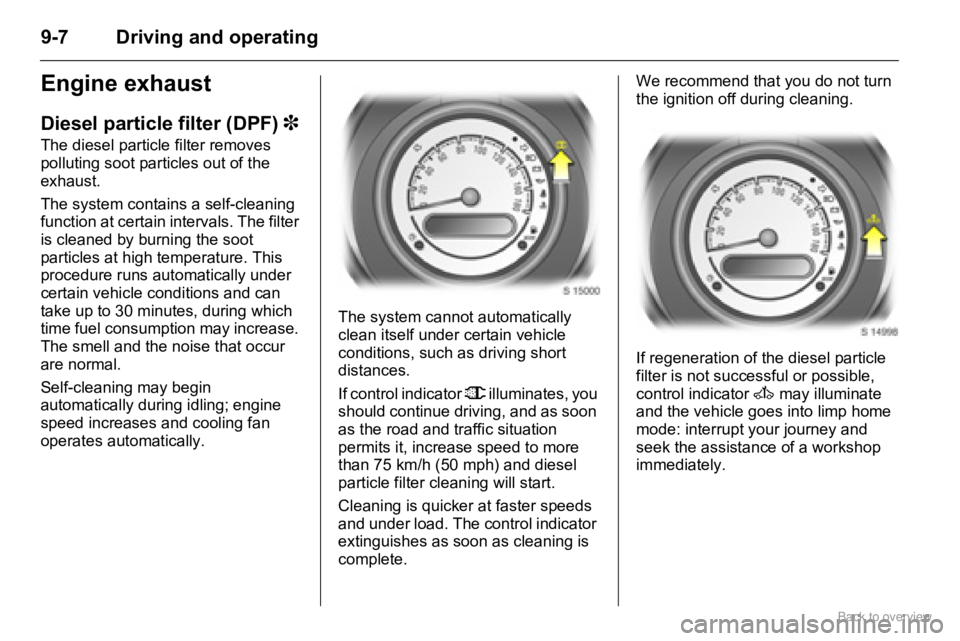2009 OPEL AGILA ECO mode
[x] Cancel search: ECO modePage 76 of 153

7-6 Infotainment system
Radio
Radio reception 3
Vehicle radio reception will differ from
that obtained with domestic radios.
As the vehicle antenna is relatively
near the ground, the broadcasting
companies cannot guarantee the
same quality of reception as is
obtained with a domestic radio using
an overhead antenna.
�„Changes in distance from the
transmitter
�„multi-path reception due to
reflection and
�„shadowing
may cause hissing, noise, distortion
or loss of reception altogether.
AM-FM radio
The Infotainment system provides the
following wavebands:
AM (Long Wave and Medium Wave)
and FM (Frequency Modulation).
In addition, a manual storing and
automatic storing facility is available
on each of the wavebands, where stations can be manually or
automatically stored and recalled
using the preset stations buttons 1-6.
Radio mode
To enter radio mode when the
Infotainment system is switched-off
or while in any other mode, press the
FM/AM button h. The last station
selected is received.
Wavebands appear in the following
order when the FM/AM button h is
pressed repeatedly:
�„FM1,
�„FM2,
�„LW,
�„MW1,
�„MW2.
Automatic search
To search for the next or previous
radio station, press and hold the
hbutton j (higher frequency) or
gbutton i (lower frequency) for
approx. 1 second and release.
The Infotainment system will tune to
the next receivable radio station on
the selected waveband.If ‘AF’ has been switched on
previously, the unit only searches for
RDS stations.
Station memory
In each waveband, 6 stations can be
stored under preset station memory
locations 1-6.
To store stations manually
Tune to the desired waveband and
station. Press and hold the preset
station button (1-6) for approx.
2 seconds where the selected station
is to be stored. Previously stored
stations are overwritten.
To store stations automatically
Tune to the desired waveband. Press
and hold the AST button 4 for
approx. 2 seconds. 6 stations with
strong signals are automatically
stored under preset station memory
locations 1-6. Previously stored
stations are overwritten.
If ‘AF’ has been switched on
previously, the unit only searches for
RDS stations.
Page 78 of 153

7-8 Infotainment system
(e.g. News). The PTY code enables
selection of the station according to
program type.
Searching for stations by
program type
Press the PTY button 8 to select
PTY mode.
Turn the bVOLUME rotary knob f
to select the desired PTY (e.g. News,
Sports).
Press the hbutton j or
gbuttoni to begin search within
the selected PTY.
If no station within the selected PTY
code is received, “NOTHING”
appears in the display followed by
“PTY”. Select another PTY as
described above.
TA (Traffic Announcement)
Traffic stations are RDS stations
which transmit traffic information.
With TA on, the Infotainment system
searches for stations emitting TP
(Traffic Programs) and tunes into
such stations in preference to others.When TA is active and a Traffic
Program is currently being received,
CD/MP3 CD 3 playback is
interrupted for the traffic
announcement and is resumed when
the announcement ends.
Switching TA on and off
Press the TA button 9 to switch on
traffic announcements.
With TA active, “TA” appears in the
display. When a Traffic Program is
currently being received, “TP” also
appears in the display.
Press the TA button 9 again to
switch off traffic announcements.
To search for a TP station (TP SEEK)
while TA is active, press the
hbuttonj or gbutton i.
If TP data is not received within
approx. 20 seconds after TA is
switched on, TP SEEK automatically
takes place only once.
If no TP station is received,
“NOTHING” appears in the display.
PS (Program Service Name)
Display of program name instead of
station frequency.
EON (Enhanced Other
Networks)
With EON, you will hear traffic
reports, even if the set station does
not transmit its own traffic
information. When a traffic
announcement is made, the unit
switches to a traffic information
station linked to EON.
When EON is active, “EON” appears
in the display.
Page 79 of 153

7-9Infotainment system
Audio players
Single CD player
The Infotainment system is equipped
with a CD player that can play audio
CDs and, if equipped, MP3 CDs 3.
The CD player will automatically
recognise the CD type.
Do not, under any circumstances,
insert DVDs, single CDs with a
diameter of 8 cm and CDs with
irregular shapes into the CD player.
These discs may becomes jammed in
the CD player or destroy the drive
mechanism, invalidating the unit’s
warranty.
The system may not be able to play
CD-Rs or play these items properly,
depending on their nature.
CD-RW discs cannot be played back
on the Infotainment system.
CD/MP3 3 playback
To enter CD mode when the
Infotainment system is switched-off
or while in any other mode, press the
CD button g if a CD is already
inserted in the audio/MP3 CD slot.If a CD is not already inserted, place
an audio CD into the CD slot with the
printed side facing upwards, just
sufficiently for it to be automatically
retracted. CD playback begins and
“CD IN” appears in the display.
Do not apply force when inserting
CDs into the slot.
Selecting next or previous track
Press the hbutton j to skip to the
next track.
Press the gbutton i once to skip
back to the start of the current track or
press it twice to skip back to the
previous track.
Fast forwards/backwards search
Press and hold the hbutton j to
fast forward through the current track.
Press and hold the gbutton i to
fast rewind through the current track.
During fast forward/rewind, the track
is played at a higher speed.
If ‘REPEAT’ has been switched on
previously and the end of the
repeated track is reached during fast forward/rewind, the repeat function is
disabled and normal playback will be
resumed.
While fast forwarding, if the end of the
disc is reached, the disc returns to the
first track.
Random play
Press the RDM button 0 to play the
tracks on the disc in random order.
“RDM” appears in the display.
Switch off random play by pressing
the RDM button 0 again.
Repeat play
Press the RPT button b to play the
current track repeatedly. “RPT”
appears in the display.
Switch off repeat play by pressing the
RPT button b again.
Scan CD
Press the SCN button e to play the
first few seconds of each track on the
disc. “SCN” appears in the display.
Switch off the scan CD function by
pressing the SCN button e again.
Page 94 of 153

9-7 Driving and operating
Engine exhaust
Diesel particle filter (DPF) 3
The diesel particle filter removes
polluting soot particles out of the
exhaust.
The system contains a self-cleaning
function at certain intervals. The filter
is cleaned by burning the soot
particles at high temperature. This
procedure runs automatically under
certain vehicle conditions and can
take up to 30 minutes, during which
time fuel consumption may increase.
The smell and the noise that occur
are normal.
Self-cleaning may begin
automatically during idling; engine
speed increases and cooling fan
operates automatically.The system cannot automatically
clean itself under certain vehicle
conditions, such as driving short
distances.
If control indicator 8 illuminates, you
should continue driving, and as soon
as the road and traffic situation
permits it, increase speed to more
than 75 km/h (50 mph) and diesel
particle filter cleaning will start.
Cleaning is quicker at faster speeds
and under load. The control indicator
extinguishes as soon as cleaning is
complete.We recommend that you do not turn
the ignition off during cleaning.
If regeneration of the diesel particle
filter is not successful or possible,
control indicator A may illuminate
and the vehicle goes into limp home
mode: interrupt your journey and
seek the assistance of a workshop
immediately.
Page 128 of 153

10-28 Vehicle care
Towing
Towing the vehicle
Towing from the front is permissible
in emergency situations only.
For fixing of the front towing eye,
remove the towing eye socket cover
by pressing the lower part of the
cover.
The towing eye attachment is stored
below the spare wheel in the luggage
compartment 3 10-25.Screw in towing eye attachment
clockwise until it is firmly in place. If
necessary, use jack handle to tighten.
Attach a tow rope 3 - or better still a
tow rod 3 - to the front towing eye.
The front towing eye must only be
used for towing and not recovering
the vehicle.
Switch on the ignition (3 9-1) to
release the steering column lock and
to permit operation of the brake
lamps and windscreen wipers.
Manual transmission in neutral,
automatic transmission 3 in N.More brake pedal pressure is
necessary when braking since the
brake servo unit is operative only
when the engine is running.
Considerably greater steering force is
necessary since this unit is operative
only when the engine is running.
To prevent entry of exhaust fumes
from towing vehicle, switch on air
recirculation mode (3 8-3) and close
the windows.
Do not tow the vehicle with a tow
rope3 or tow rod 3 for extended
periods, to avoid causing damage to
the vehicle. Only tow in this manner
on hard-surfaced roads.
Vehicles with manual or automatic
transmission3 can be towed from
the front, provided the front axle is
raised off the ground and the parking
brake is released.
Caution
Drive slowly and avoid jerky
movements. Impermissible tractive
forces could damage the vehicles.